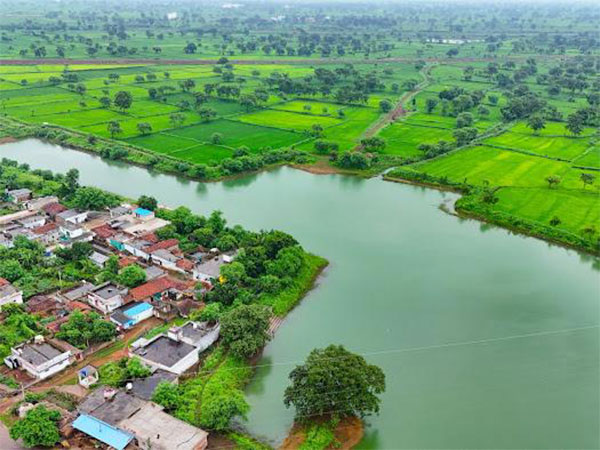Raipur (Chhattisgarh) [India], October 4 (ANI): Chief Minister Vishnu Deo Sai’s initiative of developing the largest Amritsarovar by rejuvenating a pond in Chhattisgarh’s Dhamtari district is being hailed as a futuristic move in terms of recharging ground water and connecting people with economic activities.
After a national survey report pointed out that Dhamtari district was among 150 districts across India that was prone to water depletion, the Dhamtari district administration resolved to address the issue by aiming to enhance water retention capacity through deepening and transforming ponds into Amrit Sarovar, .
In this quest, the administration developed the state’s largest nine-acre Amritsarovar by rejuvenating Mura pond in Kanharpuri gram Panchayat of Kurd Development Block. This effort not only recharged groundwater but revived parched land for agriculture farming.
Prior to deepening, the water retention capacity of Mura Pond was 32,400 cubic meters, which has now increased to 57,800 cubic meters. The depth has increased to 15 feet from 10 feet approximately. The deepening process recharged the borewell due to the water conservation structure.
After the pond has rejuvenated, nearly 50 acres of land is being irrigated and benefiting several farmers in Kanharpuri village. The pond has been holding the monsoon rainwater since June 2024 since then it has become the site of respite for villagers.
Panchayat officials and village residents said that these water storage facilities have added to the prosperity of local people as rearing livestock has become comparatively easier.
This achievement of Chhattisgarh’s rural development has been accomplished under the convergence of Gram Panchayat and South Eastern Central Railway (SECR), which proved to be an income-generating model for village Kanharpuri.
The revival of Amrit Sarovar not only generated employment under MGNERGA but created an asset at Gram Panchayat. However, the additional expansion of two acres of pond and its larger aspect of income generation came into the picture when SECR approached the Dhamtari administration to continue their project of developing a broad gauge railway track between Raipur and Dhamtari. The railway track was earmarked to pass through the village of Kanharpuri and nearby villages.
Hence, the district administration facilitated an agreement between the Railway Board and local Panchayat representatives, permitting the railway to extract soil and laterite from the Mura pond. In return, the Railway Board agreed to pay a royalty of approximately Rs 12.20 lakhs to the Gram Panchayat in exchange for soil and laterite extracted from Kanharpuri for laying the railway line. The Panchayat plans to utilize these funds for other developmental projects in the village. Eventually, the pond was mechanically excavated under the Railway Board.
Defining it as a win-win situation for Gram Panchayat and SECR, MGNREGA’s Zila Panchayat Project Officer Dharm Singh said, “As per its requirement, SECR excavated the soil from Amrit Sarovar for establishing the railway tracks but in return, Kanharpuri gram panchayat also received its royalty amount in exchange of soil. The manual excavation and deepening of the pond would have cost nearly Rs 30 lakh which was accomplished in Rs 12 lakh.”
Explaining the life of recharged ponds, the official said that prior to starting the process of revival or developing new pond, the survey report of Central Ground Water Board suggested that due to the presence of limestone in the Kurud development belt, the revived water bodies are likely to remain recharged, provided if the weather conditions also remain favourable.
Dhamtari Collector Namrata Gandhi said, “This initiative became a reality through efficient use of resources and proactive administrative efforts, aligning with the Central Government’s focus on water conservation under Prime Minister Shri Narendra Modi’s leadership.”
As per Kanharpuri Gram Panchayat’s Sarpanch Parvati Sinha, “The villagers are volunteering to protect Amrit Sarovar and assist the government in their rejuvenation. The tasks include maintaining biodiversity and self-governance in gram panchayat.”
The state government has now launched Jal Jagar- Water Conservation Awareness programs and under the Amrit Sarovar project, a total of 121 Amrit Sarovars have been proposed for the district, of which 102 have been completed, while work on the remaining 19 is in progress. A block-wise breakdown reveals that 25 Amrit Sarovars are in the Dhamtari block, 38 in the Kurud block, 29 in the Magarlod block, and 29 in the Nagri block. (ANI)
Disclaimer: This story is auto-generated from a syndicated feed of ANI; only the image & headline may have been reworked by News Services Division of World News Network Inc Ltd and Palghar News and Pune News and World News
HINDI, MARATHI, GUJARATI, TAMIL, TELUGU, BENGALI, KANNADA, ORIYA, PUNJABI, URDU, MALAYALAM
For more details and packages
















